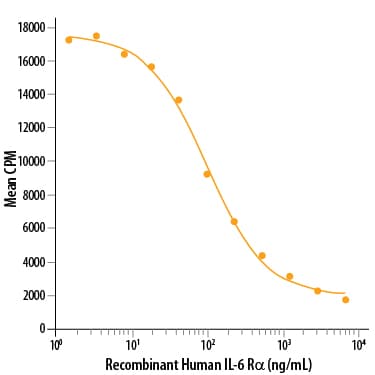Recombinant Human Proprotein Convertase 9/PCSK9 Protein, CF
Recombinant Human Proprotein Convertase 9/PCSK9 Protein, CF Summary
Product Specifications
Gln31-Gln152 & Ser153-Gln692, with a C-terminal 10-His tag
Analysis
Customers also Viewed
Product Datasheets
Carrier Free
CF stands for Carrier Free (CF). We typically add Bovine Serum Albumin (BSA) as a carrier protein to our recombinant proteins. Adding a carrier protein enhances protein stability, increases shelf-life, and allows the recombinant protein to be stored at a more dilute concentration. The carrier free version does not contain BSA.
In general, we advise purchasing the recombinant protein with BSA for use in cell or tissue culture, or as an ELISA standard. In contrast, the carrier free protein is recommended for applications, in which the presence of BSA could interfere.
3888-SE
| Formulation | Supplied as a 0.2 μm filtered solution in Tris, NaCl and Glycerol. |
| Shipping | The product is shipped with polar packs. Upon receipt, store it immediately at the temperature recommended below. |
| Stability & Storage: | Use a manual defrost freezer and avoid repeated freeze-thaw cycles.
|
Scientific Data
 View Larger
View Larger
When Recombinant Human LDL R (Catalog # 2148-LD) is coated at 2 µg/mL, Recombinant Human Proprotein Convertase 9/ PCSK9 (Catalog # 3888-SE) binds with an ED50 of 70-420 ng/mL.
Background: Proprotein Convertase 9/PCSK9
The human PCSK9 gene encodes Proprotein Convertase 9 (PC9), which is also known as Neural Apoptosis Regulated Convertase 1 (NARC1) (1). The deduced amino acid sequence of human PCSK9 consists of a signal peptide (residues 1 to 30), a pro peptide (residue 31 to 152), and a mature chain (residues 153 to 692) that contains a serine protease domain (residues 161 to 431) found in members of the furin/PC family. PCSK9 protease activity may be limited, since it has only been demonstrated through its own autocatalytic processing (2). After the autocleavage in the ER, the pro domain and mature chain exit the cell together through non‑covalent interactions (3). PCSK9 is a key regulator of LDL-cholesterol levels (LDL-C) through binding of the LDL receptor, resulting in the reduction of receptor recycling to the cell surface and the acceleration of receptor degradation in lysosomes (3). Both gain of function (GOF) and loss-of-function (LOF) mutations have been found in the PCSK9 gene (3). GOF mutations are linked to familial autosomal dominant hypercholesterolemia, a disease characterized by elevated plasma levels of LDL-C. In comparison, LOF mutations lead to low levels of LDL-C and protection against coronary heart disease.
- Seidah, N.G. et al. (2003) Proc. Natl. Acad. Sci. USA 100:928.
- Naureckiene, S. et al. (2003) Arch. Biochem. Biophys. 420:55.
- Costet, P. et al. (2008) Trends Biochem. Sci. 33:426.
Citations for Recombinant Human Proprotein Convertase 9/PCSK9 Protein, CF
R&D Systems personnel manually curate a database that contains references using R&D Systems products. The data collected includes not only links to publications in PubMed, but also provides information about sample types, species, and experimental conditions.
2
Citations: Showing 1 - 2
Filter your results:
Filter by:
-
A Virus-like particle-based bivalent PCSK9 vaccine lowers LDL-cholesterol levels in Non-Human Primates
Authors: Fowler, A;Van Rompay, KKA;Sampson, M;Leo, J;Watanabe, JK;Usachenko, JL;Immareddy, R;Lovato, DM;Schiller, JT;Remaley, AT;Chackerian, B;
bioRxiv : the preprint server for biology
Species: Primate - Macaca fascicularis (Cynomolgus Macaques)
Sample Types: Plasma
Applications: ELISA Capture -
Proprotein convertase subtilisin kexin type 9 promotes intestinal overproduction of triglyceride-rich apolipoprotein B lipoproteins through both low-density lipoprotein receptor-dependent and -independent mechanisms.
Authors: Rashid S, Tavori H, Brown P, Linton M, He J, Giunzioni I, Fazio S
Circulation, 2014-05-23;130(5):431-41.
Species: Human
Sample Types: N/A, Whole Cells
Applications: Bioassay, Western Blot
FAQs
-
Does Recombinant Human Proprotein Convertase 9/PCSK9 Protein, CF (Catalog # 3888-SE) include only the active form of the protein?
Catalog # 3888-SE is supplied as a mixture of the pro domain and the mature (active) form. The sequence is Gln31-Gln152 (pro domain) & Ser153-Gln692 (mature form), with a C-terminal 10-His tag. This sequence is based on Accession # Q8NBP7.
-
Has R&D Systems evaluated the ratio of the pro domain and the mature form in the final product of Human Proprotein Convertase 9/PCSK9 Protein, CF (Catalog # 3888-SE)?
The pro domain is the small region cleaved from the mature form. Catalog # 3888-SE undergoes autocleavage during processing to separate the pro domain and the mature form, but these remain non-covalently associated. While we have not empirically evaluated the relative levels of the pro domain and the mature form, we would expect a molar ratio of approximately 1:1.
DuoSet ELISA Development Systems
Recombinant Proteins
Supplemental ELISA Products
Reviews for Recombinant Human Proprotein Convertase 9/PCSK9 Protein, CF
Average Rating: 5 (Based on 1 Review)
Have you used Recombinant Human Proprotein Convertase 9/PCSK9 Protein, CF?
Submit a review and receive an Amazon gift card.
$25/€18/£15/$25CAN/¥75 Yuan/¥2500 Yen for a review with an image
$10/€7/£6/$10 CAD/¥70 Yuan/¥1110 Yen for a review without an image
Filter by:














